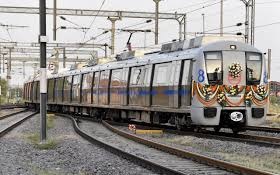Delhi Metro Rail Corporation’s (DMRC) second busiest and third oldest corridor — Blue Line (Dwarka-Vaishali/Noida Electronic City) — is all set for a major revamp. To begin with, six busy stations will be renovated and beautified, followed by other stations in later phases.
The first section of Blue Line, between Barakhamba Road and Dwarka, was opened to the public on December 31, 2005. In the next five years, the nearly 65km-long corridor expanded further inside Dwarka sub-city towards southwest and Noida and Vaishali on the eastern side. While most of the corridor was completed as part of Delhi Metro’s Phase I and II expansion by October 30, 2010, a comparatively smaller section between Noida City Centre and Noida Electronic City was opened on March 9, 2019.
With a daily footfall of more than 9.4 lakh passengers on average last month, Blue Line is the second busiest corridor of the 391km-long Delhi Metro network with a share of over 22% line utilisation. Along with Yellow Line (Samaypur Badli-Huda City Centre), Blue Line caters to half of Delhi Metro’s total traffic.
With the corridor being Delhi Metro’s workhorse for more than a decade and a half, the Blue Line stations have faced their share of wear and tear, which, according to DMRC, now requires restoration. The objective is to restore or improve facilities and services to current acceptable standards and sustain utilities and value of the facility.
The stations to be revamped include Pragati Maidan, Indraprastha, Mayur Vihar Phase-I, New Ashok Nagar, Janakpuri East and Kirti Nagar. The renovation work would include exterior and interior development and painting of the station buildings, beautification of the entry and exit areas, replacement of roof sheets, rectification of defects in structures and replacement of damaged false ceilings, leaking joints and seepage.
Expected to take around a year and half to complete, the work would cost Rs 12.7 crore, or around Rs 2.1 crore per station. The work would be challenging for DMRC as only a few hours would be available for carrying out the restoration work in the operational and busy corridor.
DMRC would start by rectifying water seepage from track beds by replacing expansion joints and providing waterproofing. The exterior facade of the stations would be renovated following the general colour theme. Apart from beautification of the entry and exit points, the approach area and surrounding portions would be revamped too. The roof sheets at the platform level, wherever required, would be replaced along with the rusted and damaged false ceilings at the concourse level.
Earlier last year, DMRC had renovated 21 of the oldest stations of the network on Red Line (Rithala-Shaheed Sthal New Bus Adda). Some of these stations were a part of the 8.4km-long first section between Shahdara and Tis Hazari that opened in 2002.

